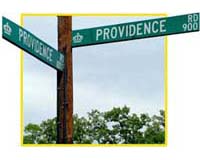Central Avenue
Why “Central” Avenue?
How the heck did Central Avenue get to be called “central”? It is a major thoroughfare through Charlotte’s east side. The street begins near the campus of CPCC — outside the central city — and runs eastward four miles to Eastland Mall. So what’s the story?
Central Avenue began life over 200 years ago as “Lawyer’s Road.” In Charlotte’s earliest days the nearest major courthouse was at Wadesboro, NC. Charlotte lawyers would follow the farm road eastward out of town on court days.
Then came the 1890s and “streetcar suburbs.” Dilworth, started in 1891, proved that well-to-do-folks would pay money for houselots at the city’s edge. In 1899 twenty-six year old George Stephens and his friend F.C. Abbott began work on a streetcar suburb they called Piedmont Park. The land, an 86 acre farm owned by Stephens’ grandfather-in-law W.R. Myers, straddled Lawyers Road for a half mile just beyond Seventh Street. Stephens and Abbott laid out new sidestreets off Lawyers Road: Sunnyside, Jackson, Piedmont, Prospect, Beaumont and Louise. Today these quiet tree-shaded avenues, running from Seventh Street near St. Martin’s Episcopal Church to Tenth Street near Piedmont Middle School, are simply considered part of the Elizabeth neighborhood.
In 1899 Piedmont Park was quite distinct, though, because its residents did not ride the Elizabeth Avenue streetcar. Instead they took a separate line out Lawyers Road.
Stephens and Abbott rebuilt the old farm road as a broad boulevard, wide and handsome as East Boulevard in Dilworth. And they gave it a fresh name to signify its new role at the center of Piedmont Park: Central Avenue.
Central Avenue quickly became “central” in another sense — a popular address for Charlotte’s business elite. Large houses arose, the grandest of which belonged to department store founder J. B. Ivey (across the street from today\’s Salvation Army).
One notable residence surviving today from that gracious era is the Charles W. Parker House at 901 Central, built in 1904 by the downtown businessman who founded Charlotte’s long-lived Parker-Gardner music store.
But Central Avenue’s fortunes began to change in 1911. George Stephens and the Myers family teamed up again to create a much grander suburb, Myers Park. Piedmont Park slowly fell out of favor.
By the 1930s many Central Avenue dwellings had become rooming houses. Young author Carson McCullers lived in one in 1938 while she wrote part of her classic novel The Heart is a Lonely Hunter.
During the 1950s bulldozers began leveling old houses one by one. McCuller’s lodging was replaced by a store building that now holds Chair and Equipment Rental. B. D. Heath’s mansion fell to build a Salvation Army headquarters. Today there is scant hint of Central Avenue’s early 20th century heyday.
But the street’s fortune’s are changing anew. Newcomers from Asia and Latin America settled in apartment complexes along the avenue’s length during the 1990s. Scores of grocery stores and butcher shops and restaurants followed. Central Avenue is now Charlotte’s premier immigrant “main street” — in a new way “central” once again.
— Tom Hanchett, Charlotte Observer, May 2000 – used with permission

Here’s a little history of just a few of Charlotte’s streets:
Sharon Road
Wilkinson Blvd
Central Avenue
Presbyterian Streets
Barringer Drive
